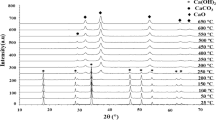Abstract
In this work, reactive iron nanoparticles dispersed in a carbon matrix were produced by the controlled thermal decomposition of Fe3+ ions in sucrose. During the sucrose decomposition, the Fe3+ ions are reduced to form iron nanometric cores dispersed in a porous carbonaceous matrix. The materials were prepared with iron contents of 1, 4, and 8 wt.% and heated at 400, 600, and 800 °C. Analyses by X-ray diffraction, Mössbauer spectroscopy, magnetization measurements, Raman spectroscopy, termogravimetric analyses, BET surface area, scanning, and transmission electron microscopy showed that at 400 °C, the materials are composed essentially of Fe3O4 particles, while treatments at higher temperatures, i.e., 600 and 800 °C, produced phases such as Fe0 and Fe3C. The composites were tested for the oxidation of methylene blue with H2O2 by a Fenton-type reaction and also H2O2 decomposition, showing better performance for the material containing 8 % of iron heated at 400 and 600 °C. These results are discussed in terms of Fe2+ surface species in the Fe3O4 nanoparticles active for the Fenton reaction.











Similar content being viewed by others
References
Brillas E, Sirés I, Oturan MA (2009) Electro-Fenton process and related electrochemical technologies based on Fenton’s reaction chemistry. Chem Rev 109:6570–6631
Costa RCC, Moura FCC, Ardisson JD, Fabris JD, Lago RM (2008) Highly active heterogeneous Fenton-like systems based on Fe0/Fe3O4 composites prepared by controlled reduction of iron oxides. Appl Catal B-Environ 83:131–139
Costa RCC, Moura FCC, Oliveira PEF, Magalhaes F, Ardisson JD, Lago RM (2010) Controlled reduction of red mud waste to produce active systems for environmental applications: heterogeneous Fenton reaction and reduction of Cr(VI). Chemosphere 78:1116–1120
Dhakshinamoorthy A, Navalon S, Alvaro M, Garcia H (2012) Metal nanoparticles as heterogeneous Fenton catalysts. ChemSusChem 5:46–64
Kuang Y, Wang Q, Chen Z, Megharaj M, Naidu R (2013) Heterogeneous Fenton-like oxidation of monochlorobenzene using green synthesis of iron nanoparticles. J Colloid Interface Sci 410:67–73
Liu S-Q, Xiao B, Feng L-R, Zhou S-S, Chen Z-G, Liu C-B, Chen F, Wu Z-Y, Xu N, Oh W-C, Meng Z-D (2013) Graphene oxide enhances the Fenton-like photocatalytic activity of nickel ferrite for degradation of dyes under visible light irradiation. Carbon 64:197–206
Machado S, Stawiński W, Slonina P, Pinto AR, Grosso JP, Nouws HPA, Albergaria JT, Delerue-Matos C (2013) Application of green zero-valent iron nanoparticles to the remediation of soils contaminated with ibuprofen. Sci Total Environ 461–462:323–329
Magalhaes F, Pereira MC, Fabris JD, Bottrel SEC, Sansiviero MTC, Amaya A, Tancredi N, Lago RM (2009) Novel highly reactive and regenerable carbon/iron composites prepared from tar and hematite for the reduction of Cr(VI) contaminant. J Hazard Mater 165:1016–1022
Mesquita I, Matos LC, Duarte F, Maldonado-Hódar FJ, Mendes A, Madeira LM (2012) Treatment of azo dye-containing wastewater by a Fenton-like process in a continuous packed-bed reactor filled with activated carbon. J Hazard Mater 237–238:30–37
Moura FCC, Oliveira GC, Araujo MH, Ardisson JD, Macedo WAA, Lago RM (2006) Highly reactive species formed by interface reaction between Fe0–iron oxides particles: an efficient electron transfer system for environmental applications. Appl Catal A-Gen 307:195–204
Oliveira PEF, Oliveira LD, Ardisson JD, Lago RM (2011) Potential of modified iron-rich foundry waste for environmental applications: Fenton reaction and Cr(VI) reduction. J Hazard Mater 194:393–398
Oliveira LCA, Fabris JD, Pereira MC (2013) Óxidos de ferro e suas aplicações em processos catalíticos: uma revisão. Quim Nova 36:123–130
Pereira MC, Tavares CM, Fabris JD, Lago RM, Murad E, Criscuolo PS (2007) Characterization of a tropical soil and a waste from kaolin mining and their suitability as heterogeneous catalysts for Fenton and Fenton-like reactions. Clay Miner 42:299–306
Pereira MC, Coelho FS, Nascentes CC, Fabris JD, Araujo MH, Sapag K, Oliveira LCA, Lago RM (2010) Use of activated carbon as a reactive support to produce highly active-regenerable Fe-based reduction system for environmental remediation. Chemosphere 81:7–12
Xu HY, Prasad M, Liu Y (2009) Schorl: a novel catalyst in mineral-catalyzed Fenton-like system for dyeing wastewater discoloration. J Hazard Mater 165:1186–1192
Xu HY, Qi SY, Li Y, Zhao Y, Li JW (2013) Heterogeneous Fenton-like discoloration of Rhodamine B using natural schorl as catalyst: optimization by response surface methodology. Environ Sci Pollut Res Int 20:5764–5772
Yao Y, Wang L, Sun L, Zhu S, Huang Z, Mao Y, Lu W, Chen W (2013) Efficient removal of dyes using heterogeneous Fenton catalysts based on activated carbon fibers with enhanced activity. Chem Eng Sci 101:424–431
Acknowledgement
The authors thank the financial support of PRPq/UFMG, FAPEMIG, CNPq, and Fundep, and the UFMG Microscopy Center (http://www.microscopia.ufmg.br) for providing the equipment and technical support for the experiments involving electronic microscopy.
Author information
Authors and Affiliations
Corresponding author
Additional information
Responsible editor: Angeles Blanco
Electronic supplementary material
Below is the link to the electronic supplementary material.
ESM 1
(DOCX 1490 kb)
Rights and permissions
About this article
Cite this article
Tristão, J.C., de Mendonça, F.G., Lago, R.M. et al. Controlled formation of reactive Fe particles dispersed in a carbon matrix active for the oxidation of aqueous contaminants with H2O2 . Environ Sci Pollut Res 22, 856–863 (2015). https://doi.org/10.1007/s11356-014-2554-z
Received:
Accepted:
Published:
Issue Date:
DOI: https://doi.org/10.1007/s11356-014-2554-z




